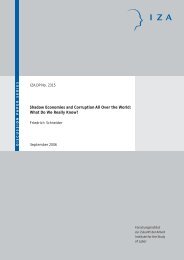The Great Recession of 2008-2009: Causes ... - Index of - IZA
The Great Recession of 2008-2009: Causes ... - Index of - IZA
The Great Recession of 2008-2009: Causes ... - Index of - IZA
- TAGS
- recession
- index
- ftp.iza.org
Create successful ePaper yourself
Turn your PDF publications into a flip-book with our unique Google optimized e-Paper software.
Of the countries that emerged from recession at the end <strong>of</strong> <strong>2009</strong>, gross capital formation has<br />
only expanded in Australia 45 , Canada, Iceland, Korea, Mexico, Norway, Switzerland, Turkey<br />
and the US, which does not bode well for the longer term growth prospects in other countries.<br />
Moreover, output growth in a majority <strong>of</strong> economies (80%) has been supported by an<br />
expansion in exports, which emphasizes the important (but potentially fragile) contribution <strong>of</strong><br />
the rebound in global trade to the recovery.<br />
5.2 Labour market remains in crisis<br />
<strong>The</strong> real test <strong>of</strong> the recovery is not whether the economy in aggregate is back on track but<br />
whether there are signs <strong>of</strong> improvement in the labour market. In this respect, unemployment<br />
continues to rise in the vast majority <strong>of</strong> OECD countries, having peaked only in Australia,<br />
Japan, Korea, Mexico and Poland (out <strong>of</strong> the 20 countries that have emerged from recession),<br />
and even in these countries, it is still too early to proclaim that the crisis in the labour market<br />
is over.<br />
Rather focusing just on the levels <strong>of</strong> employment/unemployment, a fuller insight into the<br />
state <strong>of</strong> the labour market can be gained by looking at flow data. In this respect, lay<strong>of</strong>fs<br />
peaked early in <strong>2009</strong> before returning to pre-crisis levels. This trend is evident in both the<br />
data on monthly lay-<strong>of</strong>fs at the company-level across the world in different sectors as<br />
reported by the media between December, <strong>2008</strong> and September, <strong>2009</strong> (Figure 12), and<br />
figures on flows in the US labour market (Figure 13). 46 In the case <strong>of</strong> media-announced lay<strong>of</strong>fs<br />
(which tended to be large companies), the peak occurred in January <strong>2009</strong> when almost<br />
382,000 pending dismissals were announced globally. In the US, monthly lay<strong>of</strong>fs reached a<br />
maximum <strong>of</strong> 2.5 million in the same month.<br />
45<br />
Australia did not technically enter a recession.<br />
46<br />
<strong>The</strong> firm-level figures were estimated from data reported on a bi-weekly basis in the Financial Crisis Alert<br />
Series (FCNA) compiled by the International Labour Office since mid-December <strong>2008</strong>. In all, information was<br />
available on 417 companies across the world.<br />
49
















